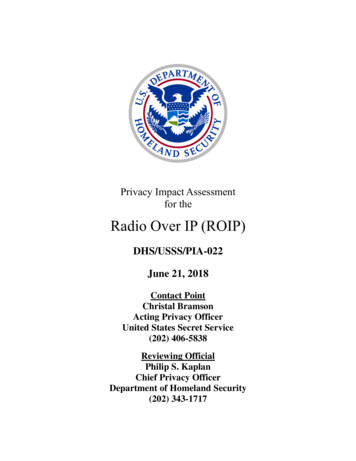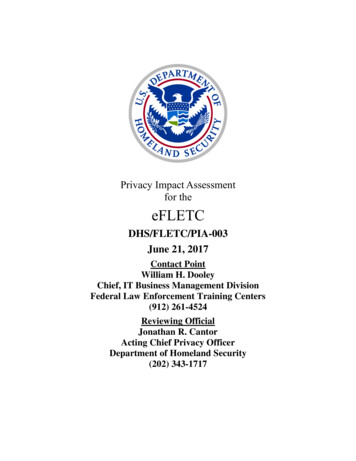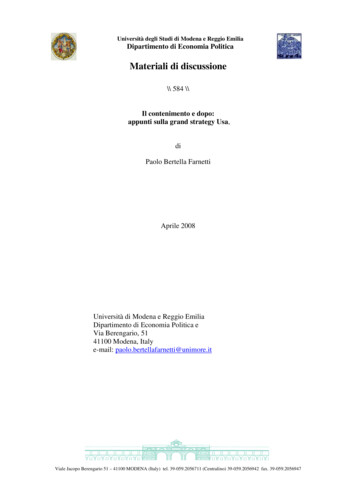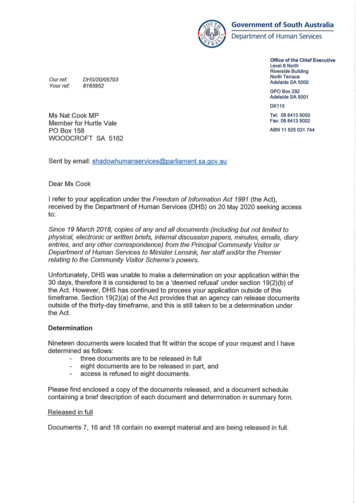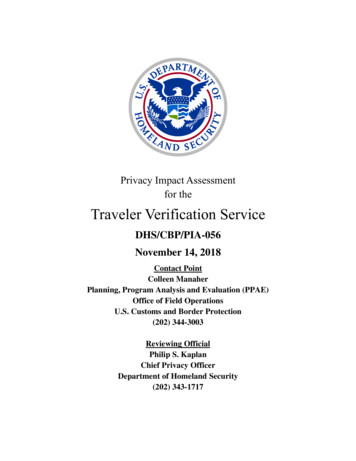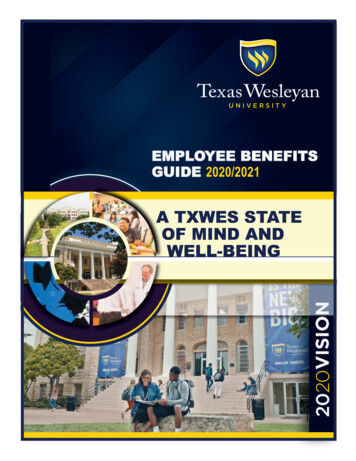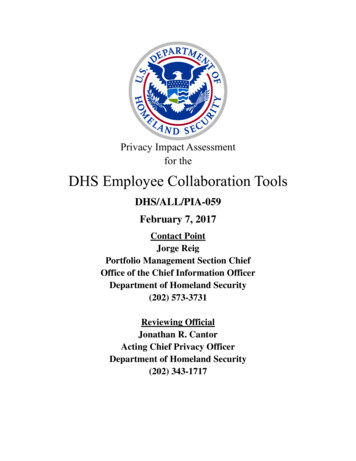
Transcription
Privacy Impact Assessmentfor theDHS Employee Collaboration ToolsDHS/ALL/PIA-059February 7, 2017Contact PointJorge ReigPortfolio Management Section ChiefOffice of the Chief Information OfficerDepartment of Homeland Security(202) 573-3731Reviewing OfficialJonathan R. CantorActing Chief Privacy OfficerDepartment of Homeland Security(202) 343-1717
Privacy Impact AssessmentDHS/ALL/PIA-059 DHS Employee Collaboration ToolsPage 1AbstractThe Department of Homeland Security (DHS) employs various cloud-based services andemployee collaboration tools to promote efficiency and improve content management andemployee communication across the enterprise. DHS cloud-based services and tools are used bythe Department and departmental programs that do not have other content tracking systems tomore effectively and efficiently manage the receipt, creation, assignment, tracking, and storage ofagency matters. DHS is conducting this Privacy Impact Assessment (PIA) because cloud-basedcontent management solutions and employee collaboration tools collect, use, store, anddisseminate personally identifiable information (PII) and sensitive PII (SPII). This PIA replacestwo previous DHS PIAs: DHS/ALL/PIA-023 DHS IdeaFactory (January 21, 2010) andDHS/ALL/PIA-037 DHS SharePoint and Collaboration Sites (March 22, 2011).OverviewOn December 9, 2010, the Office for Management and Budget (OMB) released a “25 PointImplementation Plan to Reform Federal Information Technology Management,”1 which requiredthe Federal Government to immediately shift to a “Cloud First” policy. The three-part OMBstrategy on cloud technology revolves around using commercial cloud technologies when feasible,launching private government clouds, and utilizing regional clouds with state and localgovernments when appropriate.When evaluating options for new IT deployments, OMB requires that agencies default tocloud-based solutions whenever a secure, reliable, cost-effective cloud option exists. Cloudcomputing is defined by the National Institute of Standards and Technology (NIST) as “a modelfor enabling ubiquitous, convenient, on-demand network access to a shared pool of configurablecomputing resources (e.g., networks, servers, storage, applications, and services) that can berapidly provisioned and released with minimal management effort or service providerinteraction.”2 Cloud computing is defined to have several deployment models, each of whichprovides distinct trade-offs for agencies that are migrating applications to a cloud environment.3125 Point Implementation Plan to Reform Federal Information Technology Management (December 9, 2010),available l-IT.pdf.2NIST SP-800-145 available at cialpublication800-145.pdf.3Cloud computing can be categorized into three types of service models (as defined by NIST):Cloud Software as a Service (SaaS). The capability provided to the consumer is to use the provider’sapplications running on a cloud infrastructure. The applications are accessible from various client devices through athin client interface such as a web browser (e.g., web-based email). The consumer does not manage or control theunderlying cloud infrastructure including network, servers, operating systems, storage, or even individualapplication capabilities, with the possible exception of limited user-specific application configuration settings.
Privacy Impact AssessmentDHS/ALL/PIA-059 DHS Employee Collaboration ToolsPage 2This PIA is only intended to cover internal DHS uses of cloud-based services as employeecollaboration tools. Departmental IT systems that migrate to the cloud are responsible forconducting a Privacy Threshold Analysis (PTA), and if needed, updating existing privacycompliance documentation, including PIA(s) and SORN(s). This PIA replaces two previous DHSPIAs: DHS/ALL/PIA-023 DHS IdeaFactory (January 21, 2010)4 and DHS/ALL/PIA-037 DHSSharePoint and Collaboration Sites (March 22, 2011).5DHS Cloud-Based Content Management ToolsAlthough not the only cloud-based content management tool available, many DHSorganizations rely on Microsoft SharePoint for their content management needs. SharePoint is acommercial off-the-shelf (COTS) web-based application that provides a platform on which tobuild custom applications and features a suite of collaboration, document management, andcommunication tools, as well as a high degree of integration with other Microsoft Office products.SharePoint automates the content management process, eliminating or reducing the need tomanually track emails and manage paper-based documents and forms, and promotes a moreefficient means of sharing, storing, searching, and reporting on agency information. Used as acontent management tool, the SharePoint platform enables secure data entry, standardizes thedisplay of information, and supports data management and analysis by DHS personnel.SharePoint CapabilitiesAlthough SharePoint is often used for document repository and team collaboration sites,DHS business owners have expanded their use of the product to include broader capabilities andenhanced functionality. The following provides a general description of DHS’s use of SharePointcapabilities for content management purposes: Forms management: Customized forms can be created within SharePoint so that theinformation gathered in the form can be stored in a SharePoint list or library fororganization and analysis of data. These forms can access and display data fromCloud Platform as a Service (PaaS). The capability provided to the consumer is the ability to deploy ontothe cloud infrastructure consumer-created or acquired applications created using programming languages and toolssupported by the provider. The consumer does not manage or control the underlying cloud infrastructure includingnetwork, servers, operating systems, or storage, but has control over the deployed applications and possiblyapplication hosting environment configurations.Cloud Infrastructure as a Service (IaaS). The capability provided to the consumer is to provisionprocessing, storage, networks, and other fundamental computing resources where the consumer is able to deploy andrun arbitrary software, which can include operating systems and applications. The consumer does not manage orcontrol the underlying cloud infrastructure but has control over operating systems, storage, deployed applications,and possibly limited control of select networking components (e.g., host firewalls).4DHS/ALL/PIA-023 DHS IdeaFactory (January 21, 2010), available cy pia dhs ideafactory.pdf.5DHS/ALL/PIA-037 DHS SharePoint and Collaboration Sites (March 22, 2011), available on.pdf.
Privacy Impact AssessmentDHS/ALL/PIA-059 DHS Employee Collaboration ToolsPage 3multiple sources and provide rich and interactive behaviors to aid in the collaborationand organization of information. Records management: SharePoint provides a method for systems to automaticallyarchive or expire content based on criteria set forth by the business owner. For example,a system could delete items from a list if the items are labeled as “Status Closed” andthe items are greater than three years old. Similarly, SharePoint can move items to aseparate archive list when they are better suited for long term retention. Reporting capabilities: A suite of reporting tools offers reporting and businessintelligence solutions while eliminating the need for writing custom code. These toolscan be used on specific SharePoint systems so that users can run regular or ad hocreports that suit their business needs. For example, reporting through SharePoint canbe used to manage employee workloads, manage budgets, align resources withoperational needs, or perform other trend-based or statistical reporting. Auditing capabilities: SharePoint automatically stores information on the identity ofsystem users and logs select actions users take while navigating throughout theenvironment. Tools, such as version history, can be used on SharePoint pages, lists, orlibraries to determine whether any changes were made, which user made the changes,and when the user made the changes. Microsoft Office Integration: SharePoint ties in very closely with Office products in aneffort to bring some of the native capabilities of certain Office products into SharePointsites and pages. For example, Excel Services provides the ability to present data froman Excel spreadsheet on a SharePoint page or leverage Excel data in a SharePoint listfor manipulating data. This functionality can also help to present charts and graphsfrom Excel in SharePoint which are automatically updated based on data changes thatare made in real time.Content Management (including SharePoint) Tools Privacy Considerations:DHS actively deploys content management solutions throughout the enterprise. ProgramManagers, typically referred to as Site Collection Administrators, are responsible for managingthe content of their sites. Content Management sites may include information about DHS employeesand members of the public. Most content management tools are assessed for security complianceat the enterprise or Component level, but are not assessed at the tenant, or individual site owner,level.For this reason, all collaboration site tenants must complete a PTA to: Document the purpose, use, and types of PII stored within the site; Provide visibility to their Component privacy office about the site collection;
Privacy Impact AssessmentDHS/ALL/PIA-059 DHS Employee Collaboration ToolsPage 4 Inform the enterprise-wide inventory of privacy sensitive systems; Minimize the amount of SPII stored on the site; and Receive a determination from the DHS Privacy Office on whether updates toprivacy compliance documentation are required.In addition, Component privacy officers should: Maintain an internal inventory of all collaboration sites that store SPII; Ensure that visual cues are included on each site to denote which sites areauthorized to maintain SPII and which are not.DHS Employee Collaboration ToolsTo ensure the timely, effective exchange of ideas and insights, DHS is facilitating anytime,anywhere collaboration for members of the Homeland Security Enterprise. DHS Components canchoose from a broad range of collaboration tools available, building their own collaborationportfolios based on their particular objectives and priorities.Collaboration Tool Functionality“Presence” is a foundational technology for collaboration. It detects the status ofparticipating individuals and communicates that status to authorized users. With presenceawareness, people can quickly see if someone they are trying to reach is available now, temporarilybusy, in “do not disturb” mode, or off the network altogether. This awareness allows employeesor contractors to find others who can answer their questions immediately and avoid waiting for aresponse from someone who is not likely to reply in a timely manner.Chat/instant messaging: Chat enables employees and contractors to quickly communicatewith others via typed text from desktop PCs and mobile devices. DHS use of chat or instantmessaging is enhanced with presence awareness and security controls. DHS employees andcontractors are not required to use, and may opt-out of use of, these chat/instant messaging tools.Internal enterprise social networking software: DHS organizations have deployed socialnetworking software-like tools within their closed, secure networks. These tools may include: Blogs, which foster communication about new developments to internal teams andselected external partners within the DHS enterprise; Wikis, which effectively aggregate and publish the subject matter expertise of multipleauthorized contributors; Facebook-like “walls,” which allow ongoing discussions and information-sharingabout specific topics; and
Privacy Impact AssessmentDHS/ALL/PIA-059 DHS Employee Collaboration ToolsPage 5 Social search/tagging, which lets DHS employees and contractors add keywords,descriptors, and ratings to documents and other content so that the best informationresources in the organization also become the easiest to find.Group calendars: Collaborative calendaring has become an essential tool for schedulingmeetings, coordinating travel, and otherwise ensuring that people have sufficient visibility into theactivities of anyone they need to work with.ConferencingAudio conferencing: Key attributes for effective audio conferencing include ease of use(including a simple, intuitive way to select and invite participants), good voice quality, andcomplete call management functions such as muting, secure authentication, andrecord/archive/playback controls.Video conferencing: This technology greatly enhances team communication andcollaboration by adding the significant meaning of facial expressions, hand gestures, and othervisual cues to the conversation. The types of video conferencing available today range from simpledesktop tools to high-end telepresence systems that allow participants to feel as conferenceparticipants.Web conferencing: Web conferencing allows users to share the display on their computerscreens, including documents, presentations, web browsing sessions, and active softwareprograms. This makes it useful for everything from collaborative editing to online training.Multimedia conferencing: Multimedia conferencing is the ability to mix and match theabove conferencing types, along with streaming video. For example, a multimedia conferencecould include a streaming video in the middle of a slideshow presentation, followed by a live,interactive question-and answer session.Types of Tools Used at DHSDHS organizations may subscribe to any number of employee collaboration services. Someof the most common types of cloud-based services available at DHS are:Microsoft Office 365: This is a cloud-based version of the Microsoft productivity suite,which includes email (Outlook), Skype for Business, OneDrive, Word, Excel, PowerPoint, andOneNote, that users can access from up to five different devices. Because files are stored in thecloud, users can work with and share documents wherever they are. Microsoft Office 365 alsoprovides features, such as secure project-specific websites, that allows for teams to collaborate ondocuments, coordinate schedules, and assign tasks.Microsoft Lync Online/Skype for Business: This is a cloud-based service that providesessential capabilities such as presence, instant messaging, and multimedia conferencing through aconsistent, intuitive user interface. Users can make voice calls through Lync to anyone who uses
Privacy Impact AssessmentDHS/ALL/PIA-059 DHS Employee Collaboration ToolsPage 6either Lync or Skype for Business. Lync also provides capabilities such as whiteboards and screensharing.Fair Information Practice Principles (FIPPs)The Privacy Act of 1974 articulates concepts of how the Federal Government should treatindividuals and their information and imposes duties upon Federal agencies regarding thecollection, use, dissemination, and maintenance of personally identifiable information (PII). TheHomeland Security Act of 2002 Section 222(a)(2) states that the Chief Privacy Officer shall assurethat information is handled in full compliance with the fair information practices as set out in thePrivacy Act of 1974.In response to this obligation, the DHS Privacy Office developed a set of Fair InformationPractice Principles (FIPPs) from the underlying concepts of the Privacy Act to encompass the fullbreadth and diversity of the information and interactions of DHS. The FIPPs account for the natureand purpose of the information being collected in relation to DHS’s mission to preserve, protect,and secure the homeland.DHS conducts Privacy Impact Assessments on both programs and information technologysystems, pursuant to Section 208 of the E-Government Act of 2002 and Section 222 of theHomeland Security Act of 2002. Given that DHS Cloud Based Services and EmployeeCollaboration Tools describes multiple information collections with various purposes, uses, andauthorities throughout the Department, as opposed to a particular information technology system,this PIA is conducted as it relates to the DHS construct of the FIPPs. This PIA examines the privacyimpact of DHS Cloud Based Services and Employee Collaboration Tools operations as it relatesto the FIPPs.1. Principle of TransparencyPrinciple: DHS should be transparent and provide notice to the individual regarding itscollection, use, dissemination, and maintenance of PII. Technologies or systems using PII must bedescribed in a SORN and PIA, as appropriate. There should be no system the existence of whichis a secret.Content Management Sites:Information maintained in DHS content management sites will depend on the particularbusiness processes for which the systems are established. Content management sites may serve lawenforcement, immigration, human resources, or financial management purposes. Therefore, systemsmay include a variety of information from or about the public.
Privacy Impact AssessmentDHS/ALL/PIA-059 DHS Employee Collaboration ToolsPage 7Privacy Risk: There is a privacy risk that individuals providing information to DHS donot have notice that explains their information is being stored on a server not owned or controlledby the U.S. Government, which may include a cloud-based service provider.Mitigation: This risk is partially mitigated. When possible and appropriate, DHS providesnotice to individuals about the collection and use of their information. However, in most cases, DHSdoes not provide notice that the information may be stored in a cloud-based content managementsystem at the time of collection. Regardless of storage location, content management systems thatcontain PII are governed by a SORN, when applicable, specific to the record types stored within theIT system and must be used in accordance with the purpose(s) enumerated in the SORN. The relevantSORN as well as this PIA also provide notice to the public about DHS’s collection, use, anddissemination of their information.Although explicit notice is not provided at the time of collection, DHS provides systemlocation information in all DHS SORNs. Regardless of whether the DHS data is stored on a thirdparty server or in a cloud vendor environment, the Privacy Act requirements are still applicable.Pursuant to 5 U.S.C. § 552a(m)(1), cloud service providers must adhere to the Privacy Actrequirements whenever DHS contracts with them for the operation by or on behalf of a DHS systemof records to accomplish an agency function.6Privacy Risk: There is a privacy risk that cloud service providers that are Federal Risk andAuthorization Management Program (FedRAMP) certified will conduct generic, independentassessments of the federal privacy requirements that do not meet the DHS privacy policyrequirements. For example, FedRAMP providers may provide a generic Privacy Act Statement ontheir tools that do not comply with DHS privacy policy requirements.Mitigation: All cloud service providers that contract with DHS must follow DHS privacypolicy requirements. Components that employ cloud service providers should verify that the vendorsmeet all Department privacy policy requirements, including notice.The DHS Privacy Office recommends that all cloud-based service providers and systems beincluded in the DHS Federal Information Security Modernization Act (FISMA) inventory,maintained by the Chief Information Security Office (CISO), and undergo a complete securityauthorization review.Employee Collaboration Tools:There is no privacy risk to notice for Employee Collaboration Tools. All employees areprovided with a warning banner when they access government-issued hardware, software, ornetworks (including employee messaging or collaboration tools) that they have no expectation ofSee FedRAMP standard contract clauses “The use of any information that is subject to the Privacy Act will beutilized in full accordance with all rules of conduct as applicable to Privacy Act Information,” available P Standard Contractual Clauses 062712.pdf.6
Privacy Impact AssessmentDHS/ALL/PIA-059 DHS Employee Collaboration ToolsPage 8privacy when using these tools. DHS prohibits employees from archiving message text and fromsaving conversations into their email files. Employees do not have the option to turn on thisfunction and DHS prohibits the use of messaging tools for official DHS business.2. Principle of Individual ParticipationPrinciple: DHS should involve the individual in the process of using PII. DHS should, tothe extent practical, seek individual consent for the collection, use, dissemination, andmaintenance of PII and should provide mechanisms for appropriate access, correction, andredress regarding DHS’s use of PII.Content Management Sites:Individuals seeking notification of and access to any record contained in a ContentManagement site should consult the applicable SORN, if one exists and applies to such a site, andfollow the access, correction, and amendment process noted therein.Employee Collaboration Tools:Generally, Employee Collaboration Tools are automatically populated with DHS useraccount information from Active Directory (including, email, organization, and business contactinformation). Employees may update or modify all of their information within Active Directory asneeded (to reflect a new phone number or title). Users may opt to include additional informationabout themselves, including status updates and location. Users may update this information in realtime.Privacy Risk: Because DHS data are stored on third-party servers, when an individualattempts to access his or her data, he or she may be unable to do so and may be left without properredress.Mitigation: As noted above, if a cloud service provider operating an internal employeecollaboration tool for DHS is operating a system of records, the provider must adhere to PrivacyAct access requirements. DHS employees who seek information about themselves from a newlyissued system of records, or seek to contest its content, may submit a Freedom of Information Act(FOIA) or Privacy Act request in writing to:Chief Privacy Officer/Chief Freedom of Information Act OfficerDepartment of Homeland Security245 Murray Drive, S.W.STOP-0655Washington, D.C. 20528
Privacy Impact AssessmentDHS/ALL/PIA-059 DHS Employee Collaboration ToolsPage 9FOIA requests must be in writing and include the requestor’s daytime phone number, emailaddress, and as much information as possible about the subject matter to expedite the searchprocess. Specific FOIA contact information can be found at http://www.dhs.gov/foia undercontacts.3. Principle of Purpose SpecificationPrinciple: DHS should specifically articulate the authority which permits the collection ofPII and specifically articulate the purpose or purposes for which the PII is intended to be used.Content Management Sites:Generally, DHS uses content management sites to track, manage, review, and report on anymatters related to its statutory requirements. The specific purpose of the content management sitesand the use of the information maintained within them depend on the nature of the program officeand the business process for which the system or site is established.Content management sites that contain PII are used in accordance with the purpose(s)enumerated in their relevant SORN if one covers that particular site. SORN coverage for thecollection, use, and dissemination of the information is determined through the completion of a PTA.All content management sites must display visual cues indicating whether SPII is authorizedto be posted on the system by meeting these minimum requirements:SPII-allowed site:1. A background with the text “SPII ALLOWED on this site” repeated throughout the page.2. Page headers throughout the SharePoint site with the text “SPII ALLOWED.”3. A non-removable privacy policy on the home page of each site regarding the postingof SPII on the SPII-allowed sites.Non-SPII site:1. A different colored background from the SPII-allowed sites with the text “No SPII on thissite” repeated throughout the page.2. Page headers throughout the SharePoint site with the text “No SPII.”3. A non-removable privacy policy on the home page of each site regarding the posting ofSPII on the SPII-restricted sites. The policy will include specific examples of SPII and thereasons such data cannot be posted. Contact information for the site administrator orowner will be provided in the event of accidental posting of SPII.77There may be slight variation with DHS components respective instantiations of SharePoint and the visual cuesimplemented. This sample language is meant to set the minimum standard required and establish a distinction for
Privacy Impact AssessmentDHS/ALL/PIA-059 DHS Employee Collaboration ToolsPage 10Employee Collaboration Tools:The purpose of Employee Collaboration Tools is to facilitate internal collaborationbetween DHS employees and contractors throughout the enterprise.Privacy Risk: Employee collaboration tools may be used for purposes beyond an officialDHS mission.Mitigation: DHS employees may not use chat or instant messaging tools to conductofficial DHS business. However, DHS employees may use other types of employee collaborationtools that follow DHS or NARA-records retention requirements for businesses purposes consistentwith their individual mission functions. Some Components have opted to use employeecollaboration tools (such as SharePoint’s MySite or MyProfile) to encourage employeecollaboration and unity. DHS employees should have no new purposes for using these tools otherthan they supplement existing operational readiness and do not add any new purposes.4. Principle of Data MinimizationPrinciple: DHS should only collect PII that is directly relevant and necessary toaccomplish the specified purpose(s) and only retain PII for as long as is necessary to fulfill thespecified purpose(s). PII should be disposed of in accordance with DHS records dispositionschedules as approved by the National Archives and Records Administration (NARA).Content Management Sites:Records retention and disposition in content management sites vary by the type and purposeof record collected. Content management sites may provide a method for systems to automaticallyarchive or expire content based on criteria set forth by the business owner.Privacy Risk: There is a risk that information stored in content management systems isduplicative of data stored on Departmental shared drives or in email.Mitigation: This risk is partially mitigated. When DHS migrates data to a cloud serviceprovider, the original data may remain on agency shared drives pursuant to the applicable recordsretention schedule.Recommendation: DHS program and system owners should verify that the archivedversion of their migrated data is retained in accordance with applicable record retention anddisposition rules. Program and system owners should modify systems to store federal recordmaterial in specified primary and backup archives, as applicable. After migrating to the cloud,program and system owners should also audit legacy storage locations and delete any archivedthose sites containing SPII and those that do not; it does not preclude the use of other equivalent language andcontrols.
Privacy Impact AssessmentDHS/ALL/PIA-059 DHS Employee Collaboration ToolsPage 11data that is now stored in the cloud, unless retention and disposition rules require its retention inits original system of record or data format.Employee Collaboration Tools:Regarding instant messaging tools, DHS only retains contact information from ActiveDirectory. DHS does not retain the contents of chats or instant messages.DHS employees using employee collaboration tools provide the following information viaActive Directory: first name, last name, work email address, username, work phone number, andoffice location. Some account creation pages for employee collaboration tools may include datafields for personal information, such as home phone number or home address. As a general matter,employees should not provide information beyond business contact information.Some tools, like DHS Skype for Business rely on Active Directory to pre-populate theuser’s account. In other cases, DHS may send basic business contact information, such as firstname, last name, and email address, to create an account. Any tools that require informationbeyond basic business contact information will require their own privacy compliancedocumentation.Privacy Risk: There is a privacy risk that an employee will provide more information thanis needed to create an account with an employee collaboration tool.Mitigation: This risk is partially mitigated. Many employee collaboration tools are COTSproducts, which limit the amount of customization DHS can make to the system. DHS works withvendors or contractors to try to eliminate unnecessary data fields or add asterisks to denote requiredinformation. However, in some circumstances, DHS is unable to make edits to the data fields. DHSmitigates this risk by providing guidance to the employee about creating an account.Recommendation: DHS employees and contractors should limit the information theyinclude in employee collaboration tools to business contact information and professionalachievements only. Program and system owners should remove any SPII data fields (such as dateof birth) from the COTS products whenever possible.5. Principle of Use LimitationPrinciple: DHS should use PII solely for the purpose(s) specified in the notice. Sharing PIIoutside the Department should be for a purpose compatible with the purpose for w
DHS Employee Collaboration Tools To ensure the timely, effective exchange of ideas and insights, DHS is facilitating anytime, anywhere collaboration for members of the Homeland Security Enterprise.
